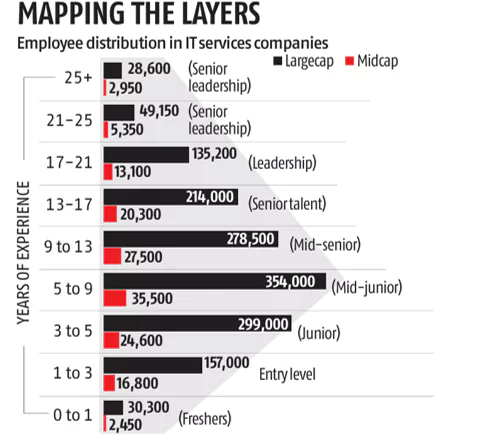IT Sector - Pyramid to Diamond Model
India’s Information Technology (IT) sector, projected to generate $283 billion in revenue in the current financial year, is undergoing a significant transformation in its organisational workforce model. This shift is largely driven by the rapid adoption of Automation, Artificial Intelligence (AI), and Generative AI (Gen AI).
Traditional Pyramid Model vs Emerging Diamond Model
- Earlier Structure: Indian IT firms followed a pyramid model, where a large base of fresh graduates formed the entry-level workforce. This model supported scalability, cost-effectiveness, and maintained bench strength (reserve workforce for future deployment).
- Current Shift: The industry is transitioning to a diamond-shaped structure, characterized by:
- Fewer entry-level hires
- Expansion of the mid-tier workforce with 5 to 13 years of experience
- This model is seen as more sustainable and responsive to modern technological demands.
Workforce Statistics (as per Xpheno Staffing Firm)
- The seven largest and ten mid-tier Indian IT firms now employ:
- Around 695,500 professionals in mid-junior to mid-senior roles
- Only 530,150 professionals at the entry level
- This data highlights the shrinking base and expanding middle in the workforce hierarchy.
Factors Driving the Shift
- Rise of AI and Gen AI:
- Many lower-level tasks like code writing are being automated
- AI tools now assist in code generation, shifting the role of engineers to code validation and supervision
- Post-Pandemic Hiring Boom and Churn:
- The 2021–22 hiring surge created a large base of 3–5 year experienced professionals
- High attrition during this period added to workforce reshaping
- Slower Economic Growth:
- In the past three years, global and domestic economic uncertainty has made firms cautious
- There is greater demand for experienced professionals who can immediately contribute without extensive training
- Client Demands and Efficiency Pressure:
- Global clients increasingly demand more efficient, leaner teams
- This discourages mass hiring of freshers, especially those needing training

Industry Voices
- The CEO of HCLTec Confirmed the structural evolution and stated that expectations from freshers will now be higher. New recruits should be capable of validating AI-generated code, not just writing it
- Co-founder of Xpheno highlighted the fat middle layer caused by the hiring boom. Ans explained that lower layers shrank due to reduced intake over the last three cycles
- The Chairman of Constellation Research observed that as more humans manage bots, the traditional command-and-control pyramid loses relevance. Automation breaks off large chunks of the pyramid, resulting in a diamond - shaped model
Implications for India’s IT Sector
- The IT industry is moving towards a leaner, more skilled workforce
- Entry-level job opportunities may decline unless freshers are multi-skilled and AI-aware.
- Skill development and reskilling of the workforce will be critical.
- There is a growing emphasis on mid-career professionals who can adapt to emerging technologies.
- Future IT services may focus more on human-AI collaboration than on traditional coding work.
UPSC Prominent Questions Asking Areas:
- What is the impact of AI on employment patterns
- What are the challenges for youth employability
- What is the importance of education system reforms to prepare graduates for an AI-driven world
- What is the Need for policy interventions to promote reskilling, upskilling, and innovation













